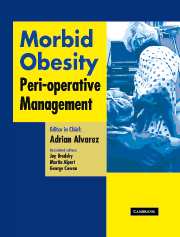Book contents
- Frontmatter
- Contents
- Contributors
- Foreword
- Preface
- Acknowledgments
- Dedication
- Section 1 General aspects
- Section 2 Pathophysiology
- Section 3 Pre-operative management
- Section 4 Peri-operative management of co-morbidities
- Section 5 Pharmacology
- Section 6 Monitoring
- Section 7 Intra-operative management
- 20 Positioning the morbidly obese patient for surgery
- 21 Airway management
- 22 Inhalational anesthesia
- 23 Total intravenous anesthesia
- 24 Anesthetic management for the obese parturient
- Section 8 Post-operative care
- Section 9 Conclusions
- Afterword
- Index
21 - Airway management
from Section 7 - Intra-operative management
Published online by Cambridge University Press: 17 August 2009
- Frontmatter
- Contents
- Contributors
- Foreword
- Preface
- Acknowledgments
- Dedication
- Section 1 General aspects
- Section 2 Pathophysiology
- Section 3 Pre-operative management
- Section 4 Peri-operative management of co-morbidities
- Section 5 Pharmacology
- Section 6 Monitoring
- Section 7 Intra-operative management
- 20 Positioning the morbidly obese patient for surgery
- 21 Airway management
- 22 Inhalational anesthesia
- 23 Total intravenous anesthesia
- 24 Anesthetic management for the obese parturient
- Section 8 Post-operative care
- Section 9 Conclusions
- Afterword
- Index
Summary
Introduction
Conventional wisdom relates morbid obesity to difficult mask ventilation (DMV) and difficult intubation. Is this born out in the literature? Yes. Difficult intubation is the second most frequent cause of malpractice claims against American anesthesiologists. Death or brain damage resulted in 57% of 283 claims involving difficult intubation, compared to 43% in all other claims. Obesity was a factor in 31% of difficult intubation claims, compared to 14% of all other claims. In obstetric patients, critical events related to the respiratory system were significantly more common among obese patients (32%) than non-obese patients (7%). This data substantiates what practitioners have known for years.
Difficult direct laryngoscopy occurs in 1.5–8.5% of intubations and failed intubation occurs in 0.13–0.3% all general anesthetics. The predictive role of obesity as an independent risk factor for difficult intubation remains somewhat controversial. Several large studies suggest that obesity may be a risk factor for difficult intubation in general surgical and obstetrical patient. Although obesity is well defined, the difficult airway is not. Consequently, it becomes problematic to study the incidence of difficulty airway in morbidly obese patients. Rose and Cohen addressed the issue of nomenclature in a study of 3325 consecutive patients for direct laryngoscopic intubation.
- Type
- Chapter
- Information
- Morbid ObesityPeri-Operative Management, pp. 287 - 296Publisher: Cambridge University PressPrint publication year: 2004



